同济大学:《经济学》课程教学资源(教案讲义)Ch16 Economic Growth
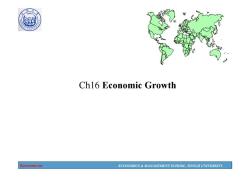
40 Ch16 Economic Growth Economics ECONOMICS MANAGEMENT SCHOOL,TONGJI UNIVERSITY
Economics ECONOMICS & MANAGEMENT SCHOOL, TONGJI UNIVERSITY Ch16 Economic Growth

1907 19-2 Economic Growth is Often measured by the rate of change of real GDP although this has many deficiencies it omits output that is not bought/sold .e.g.leisure,pollution,congestion it also neglects income distribution so higher GDP per capita does not necessarily mean greater happiness - but it helps. Economics ECONOMICS MANAGEMENT SCHOOL,TONGJI UNIVERSITY
Economics ECONOMICS & MANAGEMENT SCHOOL, TONGJI UNIVERSITY 19-2 Economic Growth is • Often measured by the rate of change of real GDP – although this has many deficiencies – it omits output that is not bought/sold • e.g. leisure, pollution, congestion – it also neglects income distribution • so higher GDP per capita does not necessarily mean greater happiness – but it helps
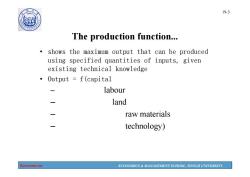
19-3 The production function... shows the maximum output that can be produced using specified quantities of inputs,given existing technical knowledge ·Output=f(capital labour land raw materials technology) Economics ECONOMICS MANAGEMENT SCHOOL,TONGJI UNIVERSITY
Economics ECONOMICS & MANAGEMENT SCHOOL, TONGJI UNIVERSITY 19-3 The production function... • shows the maximum output that can be produced using specified quantities of inputs, given existing technical knowledge • Output = f(capital – labour – land – raw materials – technology)
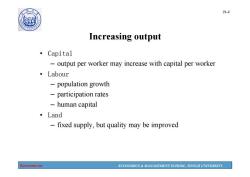
1907 19-4 Increasing output Capital output per worker may increase with capital per worker 。Labour -population growth participation rates -human capital ·Land -fixed supply,but quality may be improved Economics ECONOMICS MANAGEMENT SCHOOL,TONGJI UNIVERSITY
Economics ECONOMICS & MANAGEMENT SCHOOL, TONGJI UNIVERSITY 19-4 Increasing output • Capital – output per worker may increase with capital per worker • Labour – population growth – participation rates – human capital • Land – fixed supply, but quality may be improved
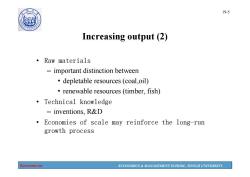
19-5 0 Increasing output (2) ·Raw materials -important distinction between depletable resources(coal,oil) renewable resources(timber,fish) ·Technical knowledge inventions,R&D Economies of scale may reinforce the long-run growth process Economics ECONOMICS MANAGEMENT SCHOOL,TONGJI UNIVERSITY
Economics ECONOMICS & MANAGEMENT SCHOOL, TONGJI UNIVERSITY 19-5 • Raw materials – important distinction between • depletable resources (coal,oil) • renewable resources (timber, fish) • Technical knowledge – inventions, R&D • Economies of scale may reinforce the long-run growth process Increasing output (2)
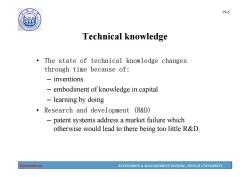
1907 19-6 Technical knowledge The state of technical knowledge changes through time because of: -inventions embodiment of knowledge in capital learning by doing Research and development (R&D) patent systems address a market failure which otherwise would lead to there being too little R&D. Economics ECONOMICS MANAGEMENT SCHOOL,TONGJI UNIVERSITY
Economics ECONOMICS & MANAGEMENT SCHOOL, TONGJI UNIVERSITY 19-6 Technical knowledge • The state of technical knowledge changes through time because of: – inventions – embodiment of knowledge in capital – learning by doing • Research and development (R&D) – patent systems address a market failure which otherwise would lead to there being too little R&D
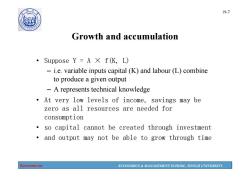
197 Growth and accumulation Suppose Y=A x f(K,L) -i.e.variable inputs capital (K)and labour(L)combine to produce a given output -A represents technical knowledge At very low levels of income,savings may be zero as all resources are needed for consumption so capital cannot be created through investment and output may not be able to grow through time Economics ECONOMICS MANAGEMENT SCHOOL,TONGJI UNIVERSITY
Economics ECONOMICS & MANAGEMENT SCHOOL, TONGJI UNIVERSITY 19-7 Growth and accumulation • Suppose Y = A × f(K, L) – i.e. variable inputs capital (K) and labour (L) combine to produce a given output – A represents technical knowledge • At very low levels of income, savings may be zero as all resources are needed for consumption • so capital cannot be created through investment • and output may not be able to grow through time
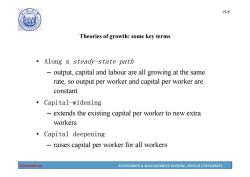
1907 19-8 Theories of growth:some key terms Along a steady-state path output,capital and labour are all growing at the same rate,so output per worker and capital per worker are constant ·Capital--widening extends the existing capital per worker to new extra workers ·Capital deepening -raises capital per worker for all workers Economics ECONOMICS MANAGEMENT SCHOOL,TONGJI UNIVERSITY
Economics ECONOMICS & MANAGEMENT SCHOOL, TONGJI UNIVERSITY 19-8 Theories of growth: some key terms • Along a steady-state path – output, capital and labour are all growing at the same rate, so output per worker and capital per worker are constant • Capital-widening – extends the existing capital per worker to new extra workers • Capital deepening – raises capital per worker for all workers
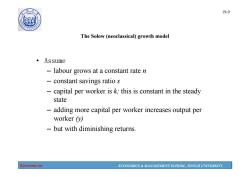
19-9 The Solow (neoclassical)growth model ·Assume labour grows at a constant rate n constant savings ratio s -capital per worker is k;this is constant in the steady state adding more capital per worker increases output per worker (v) but with diminishing returns Economics ECONOMICS MANAGEMENT SCHOOL,TONGJI UNIVERSITY
Economics ECONOMICS & MANAGEMENT SCHOOL, TONGJI UNIVERSITY 19-9 The Solow (neoclassical) growth model • Assume – labour grows at a constant rate n – constant savings ratio s – capital per worker is k; this is constant in the steady state – adding more capital per worker increases output per worker (y) – but with diminishing returns
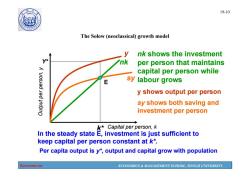
490 19-10 The Solow (neoclassical)growth model nk shows the investment nk per person that maintains capital per person while sy labour grows y shows output per person sy shows both saving and investment per person K*Capital per person,k In the steady state E,investment is just sufficient to keep capital per person constant at k*. Per capita output is y*,output and capital grow with population Economics ECONOMICS MANAGEMENT SCHOOL,TONGJI UNIVERSITY
Economics ECONOMICS & MANAGEMENT SCHOOL, TONGJI UNIVERSITY 19-10 The Solow (neoclassical) growth model Capital per person, k O u pt u t p e r p e rs o n , y nk nk shows the investment per person that maintains capital per person while labour grows y y shows output per person sy sy shows both saving and investment per person Y* Per capita output is y*, output and capital grow with population k* In the steady state E, investment is just sufficient to keep capital per person constant at k*. E
按次数下载不扣除下载券;
注册用户24小时内重复下载只扣除一次;
顺序:VIP每日次数-->可用次数-->下载券;
- 同济大学:《经济学》课程教学资源(教案讲义)Ch15 Aggregate Demand And Supply.pdf
- 同济大学:《经济学》课程教学资源(教案讲义)Ch14 Outputs and Money Market - IS-LM Model.pdf
- 同济大学:《经济学》课程教学资源(教案讲义)Ch13 Money Market Equilibrium.pdf
- 同济大学:《经济学》课程教学资源(教案讲义)Ch12-2 The Determination of Equilibrium Output.pdf
- 同济大学:《经济学》课程教学资源(教案讲义)Ch12-1 Consumption and Investment.pdf
- 同济大学:《经济学》课程教学资源(教案讲义)Ch11 National Income Accounting.pdf
- 同济大学:《经济学》课程教学资源(教案讲义)Ch09 Externalities and Public Goods.pdf
- 同济大学:《经济学》课程教学资源(教案讲义)Ch10 Overview of Macroeconomics.pdf
- 同济大学:《经济学》课程教学资源(教案讲义)Ch08 Market For Factors of Production.pdf
- 同济大学:《经济学》课程教学资源(教案讲义)Ch07 General Equilibrium and Economic Efficiency.pdf
- 同济大学:《经济学》课程教学资源(教案讲义)Ch06-2 Imperfect Competition.pdf
- 同济大学:《经济学》课程教学资源(教案讲义)Ch06-1 Analysis of Perfectly Competitive Markets.pdf
- 同济大学:《经济学》课程教学资源(教案讲义)Ch05 Analysis of Cost.pdf
- 同济大学:《经济学》课程教学资源(教案讲义)Ch04 Producer Behavior.pdf
- 同济大学:《经济学》课程教学资源(教案讲义)Ch03 Demand and Consumer Behavior.pdf
- 同济大学:《经济学》课程教学资源(教案讲义)Ch02-2 Applications of Supply and Demand.pdf
- 同济大学:《经济学》课程教学资源(教案讲义)Ch02-1 Supply and Demand.pdf
- 同济大学:《经济学》课程教学资源(教案讲义)Ch01 The Fundamentals of Economics(负责人:李永).pdf
- 同济大学:《经济学》课程教学资源(试卷习题)期终考试试卷(B卷)答案.pdf
- 同济大学:《经济学》课程教学资源(试卷习题)期终考试试卷(B卷)试题.pdf
- 吉林大学:《中央银行业务管理》课程教学资源(PPT课件)第一章 中央银行制度的形成和发展.ppt
- 吉林大学:《中央银行业务管理》课程教学资源(PPT课件)第七章 中央银行的其他业务.ppt
- 吉林大学:《中央银行业务管理》课程教学资源(PPT课件)第三章 中央银行业务活动的法规原则与资产负债表.ppt
- 吉林大学:《中央银行业务管理》课程教学资源(PPT课件)第九章 中央银行货币政策的目标与工具.ppt
- 吉林大学:《中央银行业务管理》课程教学资源(PPT课件)第二章 中央银行在现代经济体系中的地位与作用.ppt
- 吉林大学:《中央银行业务管理》课程教学资源(PPT课件)第五章 中央银行的资产业务.ppt
- 吉林大学:《中央银行业务管理》课程教学资源(PPT课件)第八章 中央银行货币政策概述.ppt
- 吉林大学:《中央银行业务管理》课程教学资源(PPT课件)第六章 中央银行的支付清算业务.ppt
- 吉林大学:《中央银行业务管理》课程教学资源(PPT课件)第十一章 中央银行的金融监管.ppt
- 吉林大学:《中央银行业务管理》课程教学资源(PPT课件)第十二章 中央银行与外汇管理.ppt
- 吉林大学:《中央银行业务管理》课程教学资源(PPT课件)第十章 货币政策的作用机制.ppt
- 吉林大学:《中央银行业务管理》课程教学资源(PPT课件)第四章 中央银行的负债业务.ppt
- 吉林大学:《中央银行业务管理》课程教学资源(PPT课件)中央银行学课程总结与辅导(共十二章,负责人:齐艺莹).ppt
- 吉林大学:《宏观经济学》课程j电子教案(PPT课件)第一章 宏观经济学导论(负责人:赵静杰).ppt
- 吉林大学:《宏观经济学》课程j电子教案(PPT课件)古典宏观经济模型.ppt
- 吉林大学:《宏观经济学》课程j电子教案(PPT课件)第二章 国民收入核算.ppt
- 吉林大学:《宏观经济学》课程j电子教案(PPT课件)第五章 通货膨胀理论.ppt
- 吉林大学:《宏观经济学》课程j电子教案(PPT课件)宏观总复习.ppt
- 吉林大学:《宏观经济学》课程j电子教案(PPT课件)第四章 货币市场的均衡.ppt
- 吉林大学:《宏观经济学》课程j电子教案(PPT课件)第四章 货币主义、供给学派和理性预期学派.ppt
